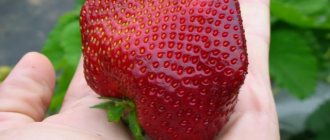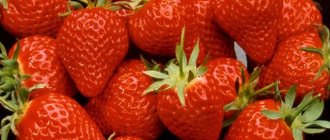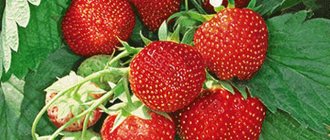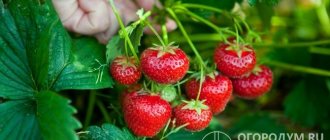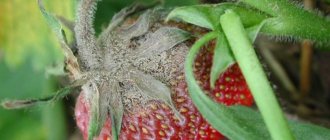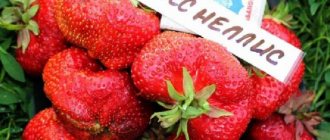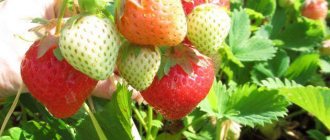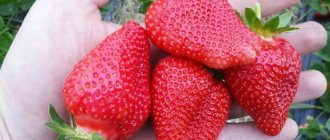Selva is a remontant variety of garden strawberries, which is excellent for growing not only in personal plots, but also on an industrial scale. The variety is quite old, it was created by American scientists in 1983. The following varieties were used to obtain Selva:
- Brighton.
- Tufts.
- Pajero.
Over the entire period of cultivation of this variety, it received a number of both positive and negative reviews. On the one hand, the variety is famous for its good performance, on the other hand, it has rather inexpressive taste.
Today we will tell you in more detail about this variety of garden strawberries. In the article you will find a description, photos of Selva berries and reviews from gardeners who have encountered this strawberry first-hand.
Description of the variety Selva
Selva strawberries are early varieties. The bushes are spreading and massive. Throughout the year, the bushes grow young foliage and grow tendrils, so that in a year you can get a lot of planting material to completely renew the plantation. The leaves are wide, dense, dark green.
Berry weight ranges from 35-60 g, cone-shaped
Flowering occurs in waves. After the first fruiting, the bushes are almost immediately covered with flowers, and the second fruiting begins. In just a year, each bush blooms 3-5 times. The flower stalks grow almost vertically, towering above the bush, but of course they can fall under the load of berries.
Interesting!
The Selva variety also has a second name. People often call him Sylvia.
Each stalk of the Selva strawberry can ripen many berries at once
Each stalk of the Selva strawberry can ripen many berries at once. The size of the berries may vary depending on the wave of fruiting. The first strawberry always grows large, but with each subsequent wave the berries become smaller, although there are much more of them. The weight of the berry is within 35-60 g. The shape of the strawberry is cone-shaped. The color of the glossy peel is scarlet, the flesh is a couple of shades lighter. There is sourness in the taste, but overall the berries are sweet.
The best varieties of large-fruited garden strawberries
First of all, summer residents are attracted by large-fruited strawberries without whiskers, the berries of which grow weighing over 30-40 grams. The stores offer dozens of varieties of domestic and foreign selection, but when choosing, you need to remember the climate characteristics of a particular area.
The characteristics stated in the descriptions show the variety in its natural conditions, but such strawberries may not be suitable for other climates
Therefore, they pay attention to the recommendations of agronomists, care features, and cold resistance indicators of Victoria for risky farming areas. The review will help you choose the most suitable species and take into account the specifics of the variety
"Queen Elizabeth"
Belongs to early strawberries, forms semi-double white flowers that completely cover the bushes. The berry is red, with a slight shine, weighing 30-50 grams. Individual specimens – 80-100 grams (see photo). According to tasters - 47 points out of 5 possible.
During the season, no more than 3-4 whiskers with 2-4 rosettes are formed. The main yield is 1.5-1.8 kg per bush, subject to proper care.
"Vima Rina"
Garden strawberries from the famous Dutch “Vima” series are part of the group of remontant species, without borers. Gives an early harvest, indicators are 0.8-1.3 kg per bush.
The berries are bright red in color, the taste is sweet with a subtle sourness. Fruiting occurs in “waves”, with 2-4 large harvests per season. Propagation is possible by seeds, as well as by dividing 2-3 year old bushes
"bolero"
A variety of English selection, resistant to natural disasters and adverse factors. It belongs to large-fruited varieties, the berries weigh 20-30 grams.
It has high immunity and bears fruit in one place for up to five years. Compact plants are convenient for planting in small areas.
"yoke"
With good care, it bears fruit up to 3-4 times a season. The bushes are lush, compact, well-leafed. Cone-shaped fruits are red-pink, with shine.
Whiskers do not form, which allows the variety to be grown in small areas in dense plantings. The fruits are suitable for transportation and retain an attractive presentation for a long time.
"merlan"
First generation F1 hybrid from Dutch breeders. Early garden strawberries form bushes up to 30-35 cm in height. Peduncles are dense, with bright pink flowers.
The beginning of flowering occurs in mid-spring (middle zone), at the end of May the first berries are collected. The fruits weigh 18-25 grams, scarlet-red, with a pronounced aroma and bright taste of strawberries. Collection from a bush - up to 1 kg.
"Pandora"
The minimum mustache is formed by the Pandora garden strawberry (Great Britain). Recommended for all regions, including areas of risky farming. It blooms in June and produces many oval-shaped berries. Weight – 45-60 grams. Pleasant taste, rich strawberry aroma, dense structure are the main characteristics of the fruit of the variety.
The variety is not remontant; it bears fruit once a season, but produces good yields. 500-600 grams are collected from a bush.
"Lubasha"
Domestic breeders gave summer residents an excellent variety of “Lyubasha”. Semi-spreading bushes do not produce tendrils and form strong, tall peduncles. The fruits are dense, regular in shape, rich red or purple in color. Weight – 20-25 grams.
Usage:
- Dessert;
- processing into compotes, preserves, jams;
- freezing
Strawberries are winter-hardy, do not reduce yield during slight cold snaps, and can withstand return frosts. Refers to remontant types of continuous fruiting.
Characteristics of Selva strawberry
Also check out these articles
- How to treat diarrhea in calves
- Description of Risen rabbits
- Watermelon Ogonyok
- Natural products and health care: why choose homemade milk?
One of the main advantages of the variety is its early ripening and remontability. Thanks to these qualities, the variety is often grown not only on private farms for their own needs, but also on large plantations for commercial purposes.
- Bud formation occurs throughout the entire growing season, so you can pick delicious, juicy berries from the plantation almost all year round.
- The immune system is strong.
- Frost resistance is high.
- The Selva variety does not tolerate prolonged stagnation of water in the soil.
- At the beginning of the fruiting period, the berries ripen unevenly, but in the middle of summer, strawberries begin to produce a massive yield, so that it becomes possible to collect large quantities of berries.
Productivity per plant per season 1-3 kg of juicy berries
- The yield per plant per season is 1-3 kg of juicy berries.
- The berries are suitable for long-term transportation. On the road, they do not wrinkle or rot if they are collected on time and correctly and placed in boxes.
- Dessert variety, sweet and sour berries.
Important!
Selva strawberries can produce a harvest not only on the mother bush, but also on the daughter rosettes, which it produces in the spring.
Pros and cons of strawberries
The main advantages of Selva, as stated above, are its resistance to cold and disease and high yield. In addition, strawberries have a pleasant appearance. Large leaves and bright red berries can greatly decorate a garden plot, so gardeners use Selva for decorative purposes.
Among the disadvantages of this variety of strawberries, the berries are not sweet enough, the berries are sour in taste, which, as the bush ages, lose their sweetness more and more, which is why the plant has to be replaced at least once every three years.
Planting strawberries
The site for planting is chosen to be sunny. Since Selva strawberries do not like stagnant water, they are planted only in well-drained soil. It is very important that the soil is soft, aerated and permeable. If there is no such area, you can arrange a high bed for strawberries or grow them in boxes with drainage holes.
Since the Selva strawberry does not like stagnant water, it is planted only in well-drained soil.
The soil should be low acidity or neutral. The ideal option is sandstone or loam. When digging up an area for planting strawberries, potassium sulfate (30 g/m2), superphosphate (50 g/m2), and humus (1 bucket/m2) are added to the soil. It is advisable to plant Selva strawberries in the spring; in the fall, they may not take root. The planting time is selected according to the weather, the main thing is that the soil has time to warm up to +18 degrees.
Important!
Selva strawberries can be grown not only in open ground or greenhouses. It is often planted in hanging pots, pyramids, multi-tiered boxes, which are placed on the sunny side of the site so that they are fully illuminated. This type of cultivation saves space on the site!
Planting is carried out with a distance of 25-30 cm between bushes and a row spacing of 60 cm
For planting, it is important to choose only strong rosettes from a healthy mother bush. Planting is carried out with a distance of 25-30 cm between the bushes and a row spacing of 60 cm. The bushes are placed in dug holes, then the roots are covered with soil so that the base of the rosette rises back with soil (it cannot be covered, otherwise the plant will rot). After planting, watering is carried out. Mulching is also recommended so that the bushes have protection from possible night cold snaps. As soon as the bush takes root, it will begin to produce flower stalks.
Selva strawberry care
We recommend reading our other articles
- When to plant cucumbers for seedlings in 2021
- Turkish clove
- Sunflower varieties
- The best early varieties of tomatoes with descriptions and photos
With quality care, Selva strawberries will delight you with productivity. But what does it need for full fruiting:
- During the first week after planting, the bushes are watered once a day so that they take root faster. They don’t spend a lot of water; systematicity is more important here, not abundance. Then watering is reduced to once every 3-4 days. If it rains regularly, watering can be stopped for a while.
If it rains regularly, watering can be stopped for a while.
- With the Selva variety, excess tendrils are rarely cut off, because they can also begin to produce crops closer to the middle or end of summer, when a large rosette develops from them.
- Fertilizers are applied under the bushes 2-3 times during the entire growing season. In spring, it is worth adding ammonium nitrate to the soil at the rate of 10 g/10 l of water. And after flowering, make a solution of 15 g of potassium salt and 20 g of superphosphate mixed with 10 liters of water. If there are bushes on the site that are 2-3 years old, then they are fed first, since the same-year-old ones will produce a good harvest without it.
- Thanks to lodging-resistant peduncles, the berries usually do not fall to the ground when ripe. But if there are a lot of them, the peduncle may fall under their load. To prevent strawberries from becoming smeared when ripe, it is advisable to lay mulch under the bushes and between the rows. It changes about once a month, sometimes more often - it depends on weather conditions. For example, if it rains constantly, the mulch will quickly rot and turn sour, so it is changed more often.
To prevent strawberries from becoming smeared during ripening, it is advisable to lay mulch under the bushes and between the rows or plant them on agrofibre
- Selva strawberries are day-neutral varieties. It produces very large yields only in the first year after planting, then the yield decreases. So it is important to renew the plantings every year.
For the winter, in cold regions, strawberries are first covered with a layer of mulch (directly on top of the leaves), then a shelter is made of agrofibre, burlap, spruce branches or similar material. It is important that the strawberries are protected from the first frosts. In winter, they simply throw snow on it, which will serve as a “fur coat” from the cold. But in warm areas, minimal winter shelter is required; it is enough to simply put straw or hay on the plantation.
Important!
Very often, before winter, all the leaves of strawberries are cut off. But in the case of the Selva variety, this cannot be done. It is the leaves that are the first level of protection of the roots from frost.
Care and cultivation
Features of watering
The Selva variety is unpretentious, but it has a special relationship with water. The slightest drying out leads to loss of harvest. Particular attention should be paid to the condition of the soil during budding, flowering and fruiting of strawberries.
Comment! When watering, you should avoid getting water on the leaves and fruits.
It is better to use drip irrigation. If there is no such system, you can use plastic bottles. The bottom part is cut off, and small punctures are made in the lid. The neck is stuck next to the Selva bush, and water is poured into the bottle. The same drip irrigation is used by many gardeners.
How to save strawberries from the heat
The plant does not like high temperatures. To prevent the soil from overheating, it must be mulched. Straw or hay can be used as mulch.
Feeding
Since the fruiting of garden strawberries of the Selva variety extends throughout the entire warm season, the plants need to be fed. Otherwise, the soil will be depleted, and the same will happen to the strawberries. Throughout the growing season, mineral fertilizers and organic matter are applied to the bushes. Fertilizers are applied simultaneously with watering.
Interesting growing options
Since the tendrils of the Selva variety are long and numerous, some gardeners grow strawberries as a climbing plant. A trellis is installed next to the bush; the Selva strawberry will cling to it with its tendrils, forming a unique corner in the garden. Imagine that on one plant, against a background of greenery, flowers sparkle white and red berries sparkle at the same time.
Strawberries of the Selva variety look good in a flowerpot or in a barrel, as an hanging plant. But in this case, garden strawberries need to be provided with adequate nutrition.
Important! You can grow the Selva variety using the Dutch method in a greenhouse to obtain a year-round harvest.
Diseases and pests of Selva
The strawberry variety Selva is resistant to many diseases. Selva does not suffer from gray rot or spotting, so if the plant has enough of all the elements, the bushes will be green throughout the entire growing season. If any disease does appear, you can use fungicides such as Kuproksat, Topaz, Bayleton to combat it.
If pests have infested a plantation, they cannot be dealt with without strong insecticides
Pests can appear on the bush, but the bushes also have immunity to their attacks. They endure damage for a long time until the pest is destroyed. The ones to be most wary of are the strawberry mite, nematode, raspberry-strawberry weevil and nettle leaf weevil.
As soon as these pests are noticed on strawberries, you need to immediately start fighting them. Treatment is carried out at the initial stage using folk remedies. An infusion of garlic, wormwood, onion peel, treatment with a solution of whey and wood ash help a lot. But if pests have infested the plantation, they cannot be dealt with without strong insecticides. In this case, use: “Fitoverm”, “Apollo”, “Karbofos”, “Metaldehyde”.
Harvesting and processing
The first fruits ripen by the end of May if the spring is sunny. If there was not enough sun, the berries can only be tasted in early June. Strawberries in open ground produce a harvest before the first cold weather (September or even early October), so it is necessary to harvest the crop more than once. The berries are collected in small batches at least daily, but in large batches - 4-5 times a year. The collected berries are stored for up to 3 weeks in a dark, cool place.
Selva in open ground produces a harvest before the first cold weather
Important!
At the beginning of autumn, selva strawberries also produce berries, but they are slightly smaller in size and their taste is reduced. So the autumn harvest is usually sent for processing.
Selva strawberries are suitable for fresh consumption, although many note that they have more acidity rather than sweetness. You can also freeze it for the winter, preserve it and dry it.
Advantages and disadvantages
The following advantages of the Selva variety can be highlighted:
- high frost and disease resistance;
- attractive appearance of berries;
- the possibility of harvesting several times per season and even year-round in greenhouses;
- good condition after transportation and storage;
- large fruits;
- versatility in use both for food and for processing.
Main disadvantages:
- ambiguous taste with excess sourness;
- relatively short lifetime with annual renewal preferred.
Despite the popularity of the Selva garden strawberry variety, opinions about it are mixed
Reviews from gardeners about Selva strawberries
What is the opinion of gardeners about Selva strawberries:
- Valentina Kibareva : “I bought Selva because friends recommended it. The bushes took root very quickly and began to bloom almost immediately. These strawberries produce a lot of harvest; one family cannot process them, so they distributed them to friends. The berries are large and beautiful, but the taste was not impressive. This variety is more suitable for canning, in my opinion, and not for food.”
- Diana Bochkareva : “Selva strawberries on my plot are grown only for sale. If I take berries for myself, it’s for processing. It makes a delicious spiced strawberry jam. It is also suitable for compotes, but the berries may fall apart in the jar. But for sale it is ideal. They buy it for its beautiful berries and pleasant taste.”
- Maxim Ognev : “If you compare the Selva variety with other American varieties, it is definitely inferior to Diamant and Albion in taste, because the acidity in the berries is too strong. But in terms of yield, I think it has no rivals. So if you need strawberries only for a large harvest, then this is an ideal option. I grow it only for sale, but for the children I planted other, sweeter varieties, which are also used for processing.”


